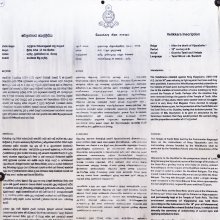Pattu, Paṭṭū, Pāttu: 8 definitions
Introduction:
Pattu means something in Hinduism, Sanskrit, Marathi, Hindi, biology, Tamil. If you want to know the exact meaning, history, etymology or English translation of this term then check out the descriptions on this page. Add your comment or reference to a book if you want to contribute to this summary article.
Images (photo gallery)
In Hinduism
Purana and Itihasa (epic history)
Source: archive.org: Puranic EncyclopediaPattu (पत्तु).—(ten) A) The ten books on rhetorics. (Alaṅkāragranthas). (See full article at Story of Pattu from the Puranic encyclopaedia by Vettam Mani)

The Purana (पुराण, purāṇas) refers to Sanskrit literature preserving ancient India’s vast cultural history, including historical legends, religious ceremonies, various arts and sciences. The eighteen mahapuranas total over 400,000 shlokas (metrical couplets) and date to at least several centuries BCE.
Biology (plants and animals)
Source: Google Books: CRC World Dictionary (Regional names)Pattu in India is the name of a plant defined with Bombax ceiba in various botanical sources. This page contains potential references in Ayurveda, modern medicine, and other folk traditions or local practices It has the synonym Gossampinus malabarica (DC.) Merr. (among others).
Example references for further research on medicinal uses or toxicity (see latin names for full list):
· Prodromus Systematis Naturalis Regni Vegetabilis (DC.) (1824)
· Flora Indica, or ‘Descriptions of Indian Plants’ (1768)
· Meletemata Botanica (1832)
· Ethnobotany (2004)
· Taxon (1979)
· Species Plantarum (1753)
If you are looking for specific details regarding Pattu, for example diet and recipes, extract dosage, health benefits, side effects, pregnancy safety, chemical composition, have a look at these references.

This sections includes definitions from the five kingdoms of living things: Animals, Plants, Fungi, Protists and Monera. It will include both the official binomial nomenclature (scientific names usually in Latin) as well as regional spellings and variants.
Languages of India and abroad
Marathi-English dictionary
Source: DDSA: The Molesworth Marathi and English Dictionarypaṭṭū (पट्टू).—f (paṭṭa S through H) A kind of woollen stuff, purpet.
Source: DDSA: The Aryabhusan school dictionary, Marathi-Englishpaṭṭū (पट्टू).—f A kind of woollen stuff, purpet.
Marathi is an Indo-European language having over 70 million native speakers people in (predominantly) Maharashtra India. Marathi, like many other Indo-Aryan languages, evolved from early forms of Prakrit, which itself is a subset of Sanskrit, one of the most ancient languages of the world.
Hindi dictionary
Source: DDSA: A practical Hindi-English dictionaryPaṭṭū (पट्टू):—(nm) a variety of coarse woollen cloth.
...
Kannada-English dictionary
Source: Alar: Kannada-English corpusPaṭṭu (ಪಟ್ಟು):—
1) [noun] a hold; seizure.
2) [noun] the quality of being tenacious; tenacity.
3) [noun] the quality or state of being unreasonably determined to have one’s own way, without yielding to reason or plea.
4) [noun] a medical substance applied on wounds, swollen part of the body etc.
5) [noun] the quality of agreeing perfectly with another’s ideas, interest, physical compatibility, etc.; harmony.
6) [noun] that which is certain.
7) [noun] a becoming thick and hard (said of a part of the skin).
8) [noun] a particular mode of fighting in wrestling or sword-fighting.
9) [noun] a number of persons classified together because of common characteristics, community of interests, etc.; a group; a faction.
10) [noun] fondness; liking.
11) [noun] (dial.) an indistinct speech.
12) [noun] the regulated closing (fullly or partially) of the holes of a flute, to produce right notes.
--- OR ---
Paṭṭu (ಪಟ್ಟು):—
1) [noun] any one of a series of moments at which the same or nearly the same thing recurs; time.
2) [noun] the number to indicate how many times a quantity is more than another quantity.
--- OR ---
Paṭṭu (ಪಟ್ಟು):—
1) [noun] a village or town.
2) [noun] a place of origin or living.
--- OR ---
Paṭṭu (ಪಟ್ಟು):—[noun] = ಪಟ್ಟಿ [patti]2.
--- OR ---
Pattu (ಪತ್ತು):—
1) [verb] to stick oneself to; to be fixed to (with or as with glue).
2) [verb] to join (oneself with); to be associated with; to join with.
3) [verb] to welded to or with.
4) [verb] to become fit; to conform suitably with.
5) [verb] to hold or seize with (one’s hands).
6) [verb] to come into physical contact with; to touch.
7) [verb] to happen; to occur; to befall.
8) [verb] to spread oneself widely.
9) [verb] to climb; to ascend; to mount up.
10) [verb] (a lamp, candle, etc.) to catch fire; to be lighted.
11) [verb] (an ointment, oil, greasy substance, etc.) to be daubed, smeared.
12) [verb] to become a friend of or related with.
13) [verb] (heat, fire) to become intense.
14) [verb] to go beneath the surface of; to sink.
15) [verb] to run behind in order to catch; to chase.
16) [verb] (an evil spirit, etc.) to possess a person and influence his behaviour, action, etc.
17) [verb] to follow or observe (a religion or religious practice).
18) [verb] to be taken up; to engage in.
19) [verb] to take (another person) into arms and press to the bosom as to express one’s affection, love, appreciation, etc.
20) [verb] to exert or have influence on; to have an effect on.
21) [verb] to form a wrinkle or wrinkles in, as by contracting.
22) [verb] to be needed; to become necessary.
23) [verb] (news, information) to reach.
24) [verb] to bend or incline the body so as to rest part of one’s weight upon or against something; to lean on.
25) [verb] to lie down; to lay oneself on.
26) [verb] to be accounted.
27) [verb] (money, wealth) to be accumulated or to grow.
28) [verb] (taste) to be felt (favourably); (a liking, inclination) to occur.
29) [verb] to be met (as on the way); to get; to arrive at.
30) [verb] to be sufficient.
31) [verb] (a plant) to develop roots (in the ground) and stand steadily.
32) [verb] (a medicine, food, etc.) to suit (the body).
33) [verb] (an expected or right price) to be got (as for a commodity being sold).
34) [verb] to have sexual intercourse.
--- OR ---
Pattu (ಪತ್ತು):—
1) [noun] the act associating or being associated.
2) [noun] the fact of being associated with; association.
3) [noun] the connection or manner of being connected or related; relation.
4) [noun] a place of protection; shelter.
5) [noun] a physical combat (as between two hostile armed force); a battle.
--- OR ---
Pattu (ಪತ್ತು):—[adjective] amounting to ten in number; ten.
--- OR ---
Pattu (ಪತ್ತು):—[noun] the cardinal number ten; 10.
--- OR ---
Pattu (ಪತ್ತು):—
1) [noun] the sun.
2) [noun] the time or period during which something happens; the period between two events.
3) [noun] the point of time when delivering of the child is due (said in relation to a pregnant woman).
4) [noun] number of times or the frequencies the same thing recurs; number of repeated occasions.
--- OR ---
Pattu (ಪತ್ತು):—
1) [noun] reliance on the integrity, strength, ability, surety, etc., of a person or thing; confidence; trust.
2) [noun] reputation or influence arising from success, achievement, rank or other favorable attributes; prestige.
--- OR ---
Pattu (ಪತ್ತು):—[noun] a resinous wood twisted at one end with long band of cloth soaked with tallow or other inflammable substances, that is lighted for using as a portable light or for holding as a symbol of respect or devotion; a torch.
--- OR ---
Pāṭṭu (ಪಾಟ್ಟು):—
1) [noun] a song or hymn.
2) [noun] a poem or poetical work.
Kannada is a Dravidian language (as opposed to the Indo-European language family) mainly spoken in the southwestern region of India.
Tamil dictionary
Source: DDSA: University of Madras: Tamil LexiconPaṭṭu (பட்டு) noun cf. பேடு. [pedu.] Hamlet, small town or village; சிற்றூர். (பிங்கலகண்டு) [sirrur. (pingalagandu)]
--- OR ---
Paṭṭu (பட்டு) noun cf. paṭṭa. [Telugu, Malayalam: paṭṭu, K. paṭṭe.]
1. Silk cloth, woven silk; பட்டாடை. (பிங்கலகண்டு) பட்டிசைந்த வல்குலாள் பாவையாள் [pattadai. (pingalagandu) pattisaintha valkulal pavaiyal] (தேவாரம் [thevaram] 863, 2).
2. Silk yarn; பட்டுப்பூச்சியால் உண்டாம் நூல். [pattuppuchiyal undam nul.]
3. Sack cloth of Indian hemp; கோணிப் பட்டை. [konip pattai.] (W.)
--- OR ---
Paṭṭu (பட்டு) noun < Telugu baṭṭu.
1. A class of panegyrists; இருந்தேத்தும் மாகதர். [irunthethum magathar.] (சிலப்பதிகாரம் அரும்பதவுரை [silappathigaram arumbathavurai] 5, 48, அரும். [arum.])
2. Panegyric chanted before kings or other great persons; கட்டியம். [kattiyam.] Local usage
--- OR ---
Paṭṭu (பட்டு) noun Poinsettia, 1. shrub, Euphorbia pulcherrima; கள்ளிவகை. [kallivagai.] Local usage
--- OR ---
Pattu (பத்து) noun [Telugu: padi, K. pattu.]
1. One more than nine; ஒன்பதோடு ஒன்று கூடிய எண். ஒன்று முதலாகிய பத்தூர் கிளவி [onpathodu onru kudiya en. onru muthalagiya pathur kilavi] (தொல். எழுத். [thol. ezhuth.] 475).
2. Group of ten patikam in Nālāyira-p-pirapantam; நாலாயிரப்பிரபந்தத்தில் பத் துப் பதிகங் கூடிய பகுதி. [nalayirappirapanthathil path thup pathigang kudiya paguthi.]
3. The tenth titi of a lunar fortnight; தசமிதிதி. ஒன்பதும் பத்தும் தேளும் [thasamithithi. onpathum pathum thelum] (விதானமாலை குணாகுண. [vithanamalai kunaguna.] 29).
4. Funeral ceremony on the tenth day of a person’s death; இறந்த பத்தாநாட் செய்யும் பிரேதச்சடங்கு. [irantha pathanad seyyum pirethachadangu.] Brāh.
--- OR ---
Pattu (பத்து) noun < பற்று. [parru.] Local usage
1. See பற்று. [parru.]
2. Field; வயல். [vayal.]
--- OR ---
Pattu (பத்து) noun < பத்தி². [pathi².] See பத்தி² [pathi²], 1. பத்துடை யடியவர்க் கெளியவன் [pathudai yadiyavark keliyavan] (நாலாயிர திவ்யப்பிரபந்தம் திருவாய்மொழி [nalayira thivyappirapandam thiruvaymozhi] 1, 3, 1).
--- OR ---
Pāṭṭu (பாட்டு) noun < பாடு-. [padu-.] [K. hāḍu.]
1. Singing, chanting; பாடுகை. [padugai.]
2. Song, hymn, that which is sung or adapted to music; இசைப் பாடல். [isaip padal.]
3. Music; இசை. கூத்தும் பாட்டும் [isai. kuthum pattum] (மணிமேகலை [manimegalai] 2, 19).
4. Verse or stanza, poem; செய்யுள். பாட்டுரைநூலே [seyyul. patturainule] (தொல். பொ. [thol. po.] 391).
5. Word; சொல் [sol] (நாநார்த்த. [nagarthathipigai] 236.)
6. Abuse; வசைமொழி. [vasaimozhi.]
--- OR ---
Pāṭṭu (பாட்டு) noun < படு¹-. [padu¹-.] Layer, pleat; கொய்சகம் முதலியவற்றின் அடுக்கு. [koysagam muthaliyavarrin adukku.] Local usage
--- OR ---
Pāttu (பாத்து) [pāttutal] 5 transitive verb < பா²-. [pa²-.] To divide; to share, apportion; பகுத்தல். நடுவணைந் திணை . . . படுதிரை வையம் பாத்தியபண்பே [paguthal. naduvanain thinai . . . paduthirai vaiyam pathiyapanpe] (தொல். பொ. [thol. po.] 2).
--- OR ---
Pāttu (பாத்து) noun < பாத்து-. [pathu-.]
1. Dividing; sharing; பகுக்கை. (சூடாமணிநிகண்டு) [pagukkai. (sudamaninigandu)]
2. Share; பங்கு. [pangu.] (நாமதீபநிகண்டு [namathipanigandu] 741.)
3. Half, moiety; பாதி. [pathi.] (W.)
4. Pair, couple; இணை. பாத்தில் புடைவை யுடை யின்னா [inai. pathil pudaivai yudai yinna] (இன்னாநாற்பது [innanarpathu] 3).
5. Separation, removal; நீக்கம். பாத்தில்சீர்ப் பதுமுகன் [nikkam. pathilsirp pathumugan] (சீவகசிந்தாமணி [sivagasindamani] 1845).
--- OR ---
Pāttu (பாத்து) noun < bhakta. [K. bhātu.]
1. Boiled rice; சோறு. (திவா.) [soru. (thiva.)]
2. Rice gruel; கஞ்சி. (சூடாமணிநிகண்டு) [kanchi. (sudamaninigandu)]
3. Pleasures of the five senses; ஐம்புலவின்பம். பாத்துண்பா னேத்துண்பான் பாடு [aimbulavinpam. pathunpa nethunpan padu] (ஏலாதி [elathi], 44).
--- OR ---
Pāttu (பாத்து) noun
1. Remission of revenue on account of failure of crops; விளைவுக் குறைச்சலுக்காகச் செய்யப்படும் வரிவஜா. [vilaivug kuraichalukkagas seyyappadum varivaja.]
2. Fixed payments of grain out of the gross produce of a village; கிராமத்தின் மொத்த விளைவி லிருந்து செலுத்தப்படும் குறிப்பிட்ட தானியவளவு. [kiramathin motha vilaivi lirunthu seluthappadum kurippitta thaniyavalavu.]
--- OR ---
Pāttu (பாத்து) noun A cant term meaning four; நான்கு என்ற பொருள்கொண்ட குழூஉக்குறி. [nanku enra porulkonda kuzhuukkuri.] (W.)
--- OR ---
Pattu (பத்து) particle
1. A prefix to numerals, meaning 'about'; எண்ணுக்கு முன் சேர்ந்து 'உத்தேசமாக' என்னும் பொருளில் வருஞ் சொல். உண்டாலும் ஒரு காலே பத்தெட்டு நாளைக்கு உண் ணவுமாய் [ennukku mun sernthu 'uthesamaga' ennum porulil varugn sol. undalum oru kale pathettu nalaikku un navumay] (நாலாயிர திவ்யப்பிரபந்தம் திருநெடுந். [nalayira thivyappirapandam thirunedun.] 1, வ்யா. [vya.]).
2. Card marked with ten pips, in playing cards; சீட்டுக் கட்டில் பத்துக்குறியுள்ள சீட்டினம். [sittug kattil pathukkuriyulla sittinam.] Local usage
--- OR ---
Pāṭṭu (பாட்டு) noun < idem. Longitudinal layer, in brick-work; செங்கற்சுவர் எழுப்பும்போது நெடுக்காக வைக்கும் கல். [sengarsuvar ezhuppumbothu nedukkaga vaikkum kal.] Local usage
Tamil is an ancient language of India from the Dravidian family spoken by roughly 250 million people mainly in southern India and Sri Lanka.
See also (Relevant definitions)
Starts with (+68): Pattu bhatta, Pattu-colankuricci, Pattu-nurkarar, Pattu-nurpucci, Pattu-ramakuricci, Pattua, Pattubhatta, Pattucattuvam, Pattuccol, Pattudale, Pattude, Pattugamthe, Pattugara, Pattugattu, Pattuge, Pattugedu, Pattugegara, Pattugegol, Pattugegolisu, Pattugegudu.
Ends with (+157): Aipattu, Aka-purapattu, Akappattu, Alappattu, Ammanaippattu, An-par-pillaipattu, Ankatappattu, Anuvapattu, Apattu, Apavargasampattu, Arshasampattu, Arthasampattu, Asurisampattu, Atukotpattu, Aurasasampattu, Badapattu, Begepattu, Bhadrakalippattu, Brahmanippattu, Calapattu.
Full-text (+333): Vayppattu, Mullaippattu, Pattukkuttai, Pattukkuncam, Pattuppati, Pattu-ramakuricci, Pattuppattavali, Pappattu, Vellippattu, Curiya-kantipattu, Pattu-colankuricci, Pumpattu, Vilvatippattu, Pattukkayili, Pattukkacceri, Sapjapattu, Vancippattu, Pattupparutti, Pullippattu, Pattukkuru.
Relevant text
Search found 12 books and stories containing Pattu, Paṭṭū, Paṭṭu, Pāṭṭu, Pāttu, Paattu, Pathu, Paathu; (plurals include: Pattus, Paṭṭūs, Paṭṭus, Pāṭṭus, Pāttus, Paattus, Pathus, Paathus). You can also click to the full overview containing English textual excerpts. Below are direct links for the most relevant articles:
The Parents < [Aug - Sept 1939]
The Bride Waits < [September-October 1933]
His Services to Tamil < [July 1970]
Puranic encyclopaedia (by Vettam Mani)
Tiruvaymoli (Thiruvaimozhi): English translation (by S. Satyamurthi Ayyangar)
Pasuram 7.3.11 < [Section 3 - Third Tiruvaymoli (Vellaic curi cankotu)]
Pasuram 5.10.11 < [Section 10 - Tenth Tiruvaymoli (Piranta arum)]
Pasuram 6.1.11 < [Section 1 - First Tiruvaymoli (Vaikal pun kalivay)]
The Religion and Philosophy of Tevaram (Thevaram) (by M. A. Dorai Rangaswamy)
Chapter 1 - Rise of the Temple cult in Saivism < [Volume 1 - Nampi Arurar’s Tevaram (his life and age)]
Chapter 4 - The Problem of Interpolation < [Volume 1 - Nampi Arurar’s Tevaram (his life and age)]
Chapter 4.6 - (k) Symbology of Kovanam < [Volume 2 - Nampi Arurar and Mythology]
Sanskrit sources of Kerala history (by Suma Parappattoli)
The Padmaneri Grant of Venkatapati I < [Chapter 1 - Historical details from Sanskrit Inscriptions]
Village Folk-tales of Ceylon (Sri Lanka), vol. 1-3 (by Henry Parker)
Story 53 - The Pots Of Oil < [Part II (b) - Stories of the Tom-tom Beaters]



